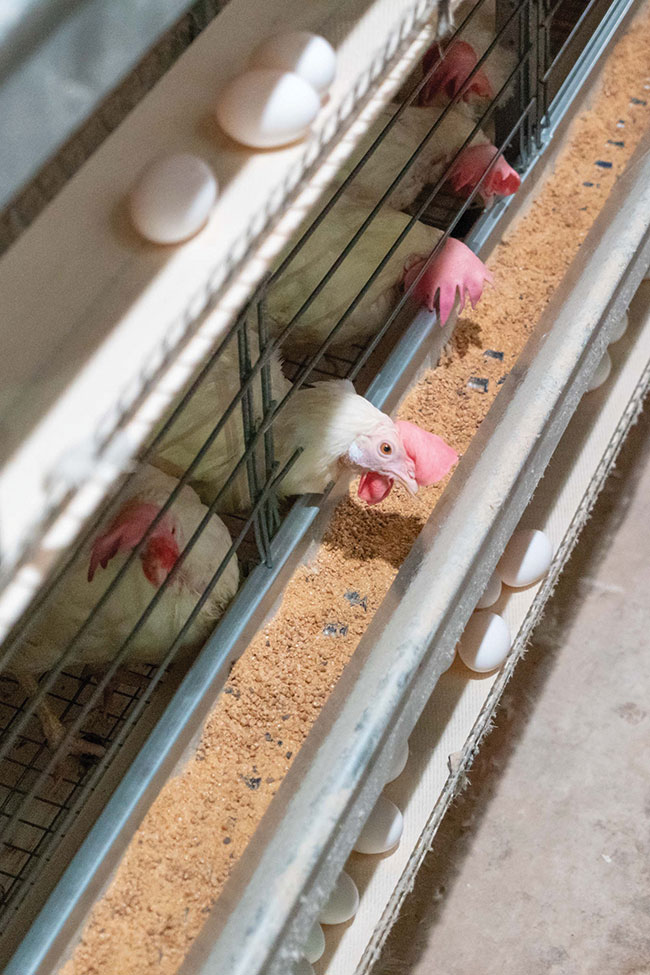
Insights on phytase supplementation
By Lilian Schaer
Features Nutrition and FeedNew research finds it could lower feed costs, increase nutrient efficiency in layers.
 University of Alberta researchers conducted the study on behalf of DuPont Animal Nutrition. PHOTO CREDIT: Big Dutchman
University of Alberta researchers conducted the study on behalf of DuPont Animal Nutrition. PHOTO CREDIT: Big Dutchman A research study completed at the University of Alberta (U of A) has found that supplementing laying hen diets with the high phytate-degrading phytase Buttiauxella sp. could lead to lower feed costs and increased overall nutrient efficiency.
Phytase releases calcium and phosphorus from ingredients in a bird’s diet that already contain those two minerals, which means the amount of calcium and phosphorus in the diet can be reduced.
“Over the years, phytases have become more effective in terms of the amount of phosphorus they can liberate, and more thermo-tolerant to handle pelleting better – this is not new, but part of the evaluation of the changing landscape of phytase use in poultry nutrition,” says Dr. Doug Korver of the Department of Agricultural, Food and Nutritional Science, who worked on the research, adding that laying hens have fairly unique calcium and phosphorus requirements that change over time.
To date, there had been little research done into the long-term impacts of phytase on calcium and phosphorus metabolism across the full length of the laying cycle. Most existing research focused only on short periods of production or involved broilers and not laying hens.
Korver and his team conducted the study on behalf of DuPont Animal Nutrition. According to poultry scientist Dr. Abiodun Bello, who took part in the research while at U of A and now works for DuPont, the company wanted to take a close look at the effectiveness of Buttiauxella sp. phytase on the long-term effects of productivity performance, eggshell quality and bone development of laying hens.
Typical for a phytase study, this trial included: A positive control group with normal calcium and phosphorus levels that followed primary breeder recommendations but no phytase; a negative control group with reduced calcium and phosphorus levels; and a negative control group with 300 FTU (phytase units) per kilogram added phytase.
Researchers studied a total of 456 Lohmann LSL Lite white laying hens from the U of A flock from 27 to 70 weeks of age. They measured egg production, body weight, feed intake, feed conversion ratio and eggshell quality from 30 to 70 weeks of age. The team also tracked apparent digestibility of phosphorus and calcium and bone quality at 32, 48 and 70 weeks of age.
“What we found is that management guides recommend far more calcium and phosphorus than a bird actually requires, so the negative control group still had plenty of calcium and phosphorus and we didn’t see a reduction in performance,” Korver says. “We did see a very minor reduction in bone quality but not enough to affect health.”
“Our conclusion is that we can probably go even lower in calcium and phosphorus in commercial laying hen diets because we are feeding more than they need, and we can go even further if we add phytase,” he adds.
Not only would this reduce feed costs for producers – phosphorus is not an inexpensive additive – but there are environmental benefits as well stemming from lower phosphorus levels in poultry manure. That’s because birds absorb only the minerals and nutrients they need and excrete the rest.
According to Korver, there is also evidence that excessive phosphorus levels affect egg shell quality. As the industry moves to ever-longer production cycles, one of the limiting factors is declining shell quality as birds approach the end of production, which he believes could be addressed by feeding lower levels of calcium. Here too, those levels could potentially be dropped even further by adding phytase.
“The cost [of adding phytase] is much less than adding phosphorus in broilers. It’s a minor cost to add the phytase; you save money by not including inorganic phosphates,” he says.
According to Bello, researchers conducted a follow-up study with lower amounts of dietary calcium and phosphorus than in Korver’s work at U of A. This trial showed that using Buttiauxella sp. phytase at 300 to 600 FTU per kilogram resulted in higher reductions of available phosphorus and calcium, but without any detrimental effects on egg productivity, eggshell and bone quality traits.
The key takeaway for producers?
Although researchers need to conduct more work to determine what the optimal levels of calcium and phosphorus would be in laying hen diets, using Buttiauxella sp. phytase in laying hen diets can lower feed costs and increase overall bird nutrient efficiency.
Print this page